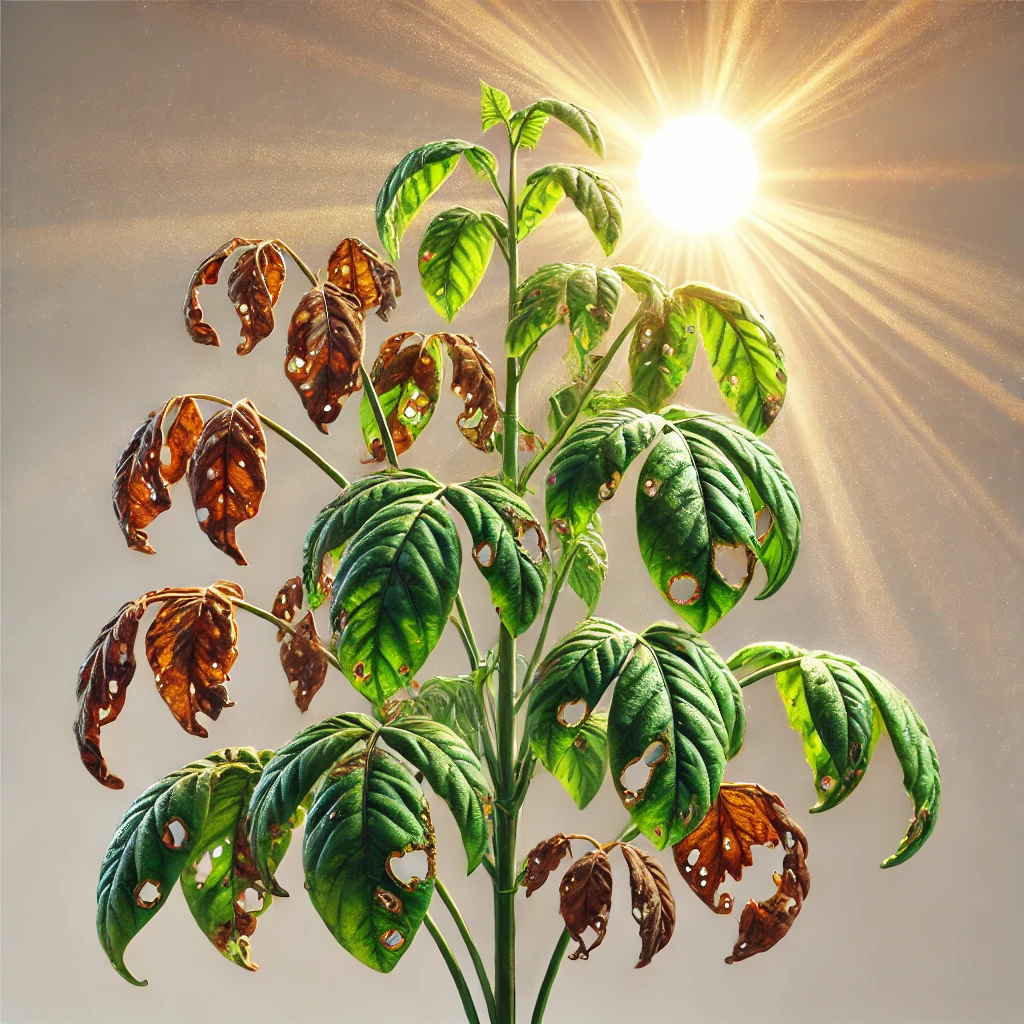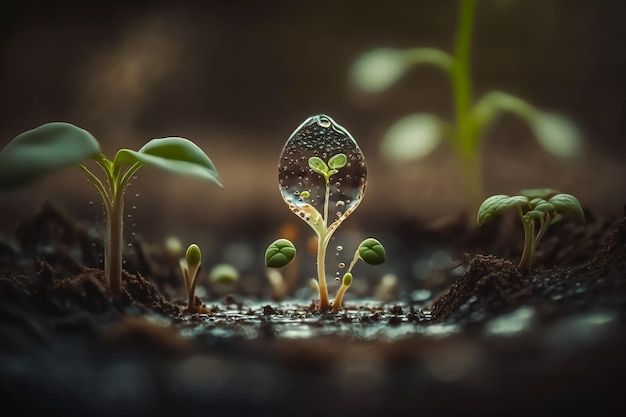Abiotic stresses—such as drought, salinity, extreme temperatures, and nutrient deficiencies—pose serious threats to global agriculture, reducing crop yields and threatening food security. Plants, being sessile organisms, cannot escape these challenges. Instead, they rely on an intricate network of signaling pathways to adapt and survive. At the heart of this adaptive machinery lie phytohormones, the chemical messengers that regulate plant growth, development, and stress responses. But what makes their role even more fascinating is not their individual action alone, but the crosstalk—the complex interplay among multiple hormones—that fine-tunes the plant’s physiological responses to stress.
In this article, we explore the dynamic and multilayered communication among phytohormones during abiotic stress, shedding light on how plants coordinate defense, growth, and survival under challenging environments.
The Major Players: A Brief Overview of Key Phytohormones
While several plant hormones contribute to abiotic stress responses, the key players include:
Abscisic acid (ABA): The “stress hormone,” known for regulating stomatal closure, root growth, and gene expression during drought and salinity. Auxin (IAA): Primarily involved in cell elongation, root patterning, and development; its distribution changes drastically under stress. Cytokinins (CKs): Associated with cell division and shoot growth; they are often antagonistic to ABA. Ethylene: A gaseous hormone modulating senescence, root development, and oxidative stress responses. Salicylic acid (SA): Traditionally known for its role in biotic stress, but increasingly implicated in abiotic defense. Jasmonic acid (JA): Plays a role in oxidative stress management and root architecture during stress. Brassinosteroids (BRs): Steroidal hormones that enhance tolerance by regulating antioxidative enzymes and stress-responsive genes. Gibberellins (GAs): Promote growth, but their biosynthesis is usually downregulated under stress to conserve resources.
Each hormone can activate unique responses, but it is their synergistic and antagonistic interactions that orchestrate a holistic adaptation strategy.
ABA: The Master Regulator of Drought and Salinity Responses
Abscisic acid is rapidly synthesized in response to drought and salinity, and serves as a central node in stress signaling. Its role in stomatal closure conserves water by minimizing transpiration, while it also induces the expression of stress-responsive genes such as dehydrins, LEA proteins, and ROS scavengers.
However, ABA doesn’t act alone. It integrates signals from other hormones. For example, ABA and ethylene often work together to regulate stomatal function, while ABA and cytokinins typically act antagonistically. Under drought, increased ABA levels suppress cytokinin biosynthesis, leading to the arrest of cell division and promotion of root elongation to access deeper water.
Auxin and Its Redistribution Under Stress
Auxin homeostasis and transport are highly sensitive to environmental cues. Under abiotic stress, auxin transporters such as PIN proteins are relocalized, altering auxin gradients and thereby changing root architecture.
For instance, during drought, auxin accumulation in the root tip promotes lateral root inhibition but encourages primary root elongation. This adaptive trait increases root depth, improving water acquisition. Moreover, auxin-ABA crosstalk is pivotal: ABA regulates the expression of auxin biosynthetic genes, while auxin controls ABA receptor abundance, forming a feedback loop.
Auxin also interacts with ethylene in a context-dependent manner. In waterlogged conditions, ethylene accumulation promotes adventitious root formation, an auxin-dependent process that enhances survival.
Cytokinin Antagonism and Root-Shoot Prioritization
Cytokinins often play a growth-promoting role under normal conditions but are downregulated during stress to divert resources towards survival. Under drought and salt stress, reduced cytokinin levels result in growth retardation and leaf senescence, processes necessary for stress endurance.
This reduction is largely mediated by ABA signaling, which suppresses cytokinin biosynthesis and transport. Interestingly, cytokinins also modulate ABA sensitivity. In some cases, exogenous application of cytokinins has been shown to improve drought tolerance by maintaining chlorophyll content and delaying senescence—indicating that the outcome of their interaction with ABA can vary depending on concentration, timing, and tissue specificity.
Ethylene: A Dual Role in Tolerance and Senescence
Ethylene is often seen as a stress-responsive hormone, being rapidly produced under drought, salt, and temperature extremes. It plays a central role in leaf abscission, senescence, and growth inhibition—processes that are sometimes necessary to limit damage.
However, ethylene also activates tolerance mechanisms. For example, it regulates the expression of ROS-detoxifying enzymes like SOD and catalase, and it induces genes like ERFs (ethylene response factors) that help cells withstand osmotic stress.
Ethylene interacts extensively with ABA and auxin. In salt stress, ethylene can suppress ABA-mediated stomatal closure, balancing the need for gas exchange and water conservation. In drought, ethylene can work with auxin to remodel root systems, encouraging growth of drought-adaptive structures.
Salicylic Acid and Jasmonic Acid: Linking Biotic and Abiotic Stresses
Salicylic acid (SA) and jasmonic acid (JA) are better known for their roles in pathogen defense, but recent findings show they also contribute to abiotic stress responses.
SA enhances antioxidant defenses and stabilizes membranes under heat and salinity stress. It may function synergistically with ABA to induce defense gene expression, while also antagonizing ethylene in some contexts to prevent excessive cell death.
Jasmonic acid, on the other hand, modulates root development and ROS homeostasis. JA-induced expression of heat shock proteins (HSPs) and antioxidative genes has been observed under thermal and oxidative stress. Interestingly, JA and ABA often co-regulate stress-responsive transcription factors like MYC2, forming a cooperative defense module.
Brassinosteroids: The Growth-Stress Balancers
Brassinosteroids (BRs) are potent growth regulators that also improve tolerance to abiotic stress by enhancing photosynthetic efficiency, cell wall strength, and antioxidant defenses. BRs induce stress-responsive genes such as HSPs, dehydrins, and enzymes in the phenylpropanoid pathway.
In terms of crosstalk, BRs often synergize with ABA to enhance stress tolerance but can also counteract ABA’s growth-inhibiting effects under moderate stress. BRs also interact with JA and SA in ROS management, and with gibberellins in developmental regulation, balancing growth and stress responses.
Gibberellins and Growth Suppression Under Stress
Gibberellins (GAs) promote stem elongation, flowering, and seed germination. However, under stress, GA biosynthesis is often suppressed to halt growth and conserve energy. This suppression is regulated by ABA and ethylene.
Notably, DELLA proteins, which are negative regulators of GA signaling, accumulate during stress and promote tolerance by activating antioxidant genes and modulating cross-hormonal responses. DELLA proteins are now recognized as integrators of GA, ABA, JA, and BR signaling, controlling trade-offs between growth and stress defense.
Mechanistic Insights: Transcription Factors and Signaling Modules
Crosstalk among hormones is often mediated through shared transcription factors such as:
AREB/ABFs – Integrate ABA and drought responses ERFs – Mediate ethylene and JA signals WRKYs – Involved in ABA, SA, and JA regulation DREB/CBF – Crucial for cold and drought response, often ABA-independent
Additionally, second messengers like calcium ions (Ca²⁺), ROS, and inositol phosphates serve as convergence points for hormone signals, integrating external stress cues into a coordinated response.
Biotechnological Applications and Future Directions
Understanding phytohormone crosstalk has direct implications for crop improvement. Genetic engineering and CRISPR-based modulation of hormone biosynthesis, signaling, and transport can lead to stress-resilient varieties.
For example:
Overexpression of NCED (a key ABA biosynthesis gene) improves drought tolerance. Manipulating PIN transporter genes alters auxin distribution for better root systems. Mutants of GA biosynthesis genes with reduced growth but improved stress tolerance have been explored in rice and wheat.
Future research must focus on hormonal interactions in specific tissues, under field-relevant stress combinations, and timing of hormonal responses, which are critical for trait optimization.
Conclusion: Embracing the Complexity
Plant responses to abiotic stress are governed not by a single hormone but by a symphony of hormonal signals. The crosstalk among phytohormones enables plants to fine-tune their growth and defense strategies under constantly changing environments. As climate change intensifies and stress combinations become the norm, understanding these intricate networks will be essential for developing the next generation of climate-smart crops.
By delving deeper into phytohormone crosstalk, plant scientists and breeders can unlock nature’s blueprint for resilience—turning complexity into opportunity.
References
Bari, R., & Jones, J. D. G. (2009). Role of plant hormones in plant defence responses. Plant Molecular Biology, 69(4), 473–488. https://doi.org/10.1007/s11103-008-9435-0
Cutler, S. R., Rodriguez, P. L., Finkelstein, R. R., & Abrams, S. R. (2010). Abscisic acid: Emergence of a core signaling network. Annual Review of Plant Biology, 61, 651–679. https://doi.org/10.1146/annurev-arplant-042809-112122
Depuydt, S., & Hardtke, C. S. (2011). Hormone signalling crosstalk in plant growth regulation. Current Biology, 21(9), R365–R373. https://doi.org/10.1016/j.cub.2011.03.020
Raghavendra, A. S., Gonugunta, V. K., Christmann, A., & Grill, E. (2010). ABA perception and signalling. Trends in Plant Science, 15(7), 395–401. https://doi.org/10.1016/j.tplants.2010.04.006
Wasternack, C., & Strnad, M. (2019). Jasmonates and Brassinosteroids—A Dynamic Duo in Plant Development and Stress Responses. Frontiers in Plant Science, 10, 1232. https://doi.org/10.3389/fpls.2019.01232
Verma, V., Ravindran, P., & Kumar, P. P. (2016). Plant hormone-mediated regulation of stress responses. BMC Plant Biology, 16(1), 86. https://doi.org/10.1186/s12870-016-0771-y
Santner, A., & Estelle, M. (2009). Recent advances and emerging trends in plant hormone signalling. Nature, 459(7250), 1071–1078. https://doi.org/10.1038/nature08122
Yu, Y., Wang, J., Zhang, Z., Quan, R., Zhang, H., Deng, X., & Zhang, H. (2017). Hormonal crosstalk in plant heat stress responses. Plant Cell Reports, 36(5), 791–800. https://doi.org/10.1007/s00299-017-2110-5
Gupta, A., Hisano, H., Hojo, Y., Matsuura, T., Ikeda, Y., Mori, I. C., & Senthil-Kumar, M. (2020). Global profiling of phytohormone dynamics during combined drought and pathogen stress in Arabidopsis. Environmental and Experimental Botany, 177, 104146. https://doi.org/10.1016/j.envexpbot.2020.104146
Claeys, H., & Inzé, D. (2013). The agony of choice: How plants balance growth and survival under water-limiting conditions. Plant Physiology, 162(4), 1768–1779. https://doi.org/10.1104/pp.113.220921










